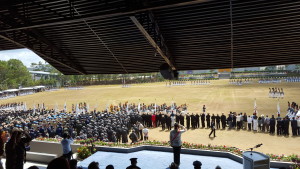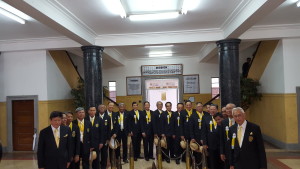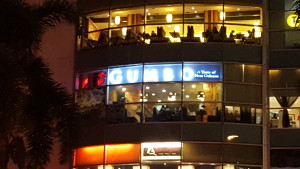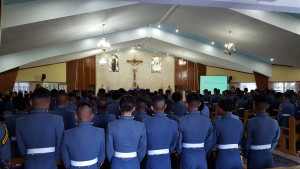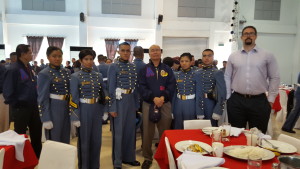Postcoloniality from the Edges: Black Culture at the Philippine Military Academy
Somewhere deep inside every historian resides a frightened, under-trained anthropologist. Like many historians, I often praise my students when they write with that ever-elusive “anthropological sensibility.” But anthropologists we are not. This fact became painfully obvious to me during my time in the Philippines. In a particularly acute moment I found myself in the middle of a world that my historical training left me almost entirely unprepared to analyze—the hallowed grounds of the Philippine Military Academy. If U.S. readers can imagine West Point, Harvard Business School, an APEC Conference, a NAM Summit, a high school reunion, and a college frat house all rolled into one, you might begin to grasp a small slice of what I experienced at the PMA’s annual homecoming celebration from February 19th to 21st. Like everywhere else I visited in the Philippines, the campus’s remote location in the colonial summer capital of Baugio was teeming with black culture.
My crew for the weekend was the PMA Class of 1966 who were being honored as Golden Jubilarians.
Many of them were born as colonial subjects in an American occupied Philippines. As military generals, business moguls, and high ranking politicians who came into their own under a marginally postcolonial Philippine state, many were on opposite sides of one another during the EDSA Revolution of 1986 that toppled the Marcos regime. As we rolled in our tricked out charter buses (complete with plastic seat covers reminiscent of so many Compton living rooms that I knew growing up) the six hour playlist going up the mountain included hours of America military marching anthems interspersed with the greatest hits of Brian McKnight. Hopping from one glamorous banquet spread to another and from a luxury hotel to an elite private country club, I got a glimpse at what life is like for the ruling Philippines political class. And it was filled with black culture.
As the only non-Filipino on the bus, (and perhaps among the 9,140 invited guests in attendance as well) it took some time for everyone to warm up to me. But once the alumni association president felt compelled to pull me aside to tell me a bestiality joke involving a fellatio giving camel and his masturbating jockey, I knew I was part of the family. Soon the stories began flowing like the gumbo served at the Gateway shopping mall back in Manila.
At first, all anyone wanted to talk about was Donald Trump. This put the 70 to 80 year old PMA graduates in league with nearly every professor, college student, and gym rat that I met during my time in the Philippines. “What’s wrong with America?” they asked. “The same thing that is always wrong with America,” I replied. Once I told them I was in the country to chronicle the lives of African Americans in the Philippines, the floodgates opened further. It seems that everyone knew someone who was black in the Philippines.
Among other tales, I was told about a black four star general in the Philippine Army who was the descendant of a black private in the American Army who came during the Philippine American War. He and his brothers were all PMA graduates, indicating few barriers and little overt racism to black military officers at the PMA. At the same time, however, the apparent muscularity, athletic prowess, and sexual endowment of the brothers were offered up as bodily proof of their collective blackness. “Filipinos have little penises,” I was assured. Apparently American colonialism left behind more than winding roads and jeepneys. The prevalence of skin whitening ads on television and the sight of sun shielding umbrellas in the 90 degree heat only further confirmed this persistent cloud of coloniality that hung over the Philippines.
Yet, just as one could find a collection of black mammies hung on the wall at a local eatery, one could also see at that very same restaurant a touching tribute to Jimi Hendrix and a sympathetic rendering by a local Filipino artist of an African tribesman.
Few aspects of black culture were as obvious, however, as those transmitted to the Philippines through the corporate sports entertainment industry. A Catholic bishop on our charter bus told me of his undying love for Steph Curry along with his hatred of Marxist inspired liberation theology. I couldn’t help but think of him cheering loudly in his bath robe for the Splash Brothers on a Saturday afternoon as I heard him in his priestly robes give his guest sermon to PMA cadets during their mandatory mass for the 2nd Sunday of Lent. The military/religious discipline and the almost complete collapse between church and state made the phrase “For God and Country” seem real in a way that we can only imagine in the U.S.
The bishop was not alone in his love for the NBA and all things basketball. Golden State Warriors jerseys are everywhere on the streets of Manila. Black players are equally celebrated in the Philippines Basketball Association, where each team is allowed one invariably black “import” player whose bodies are measured to insure that they are not over 6’5” or 6’9” tall, depending on the season. In every barrio town and rural village I saw, flip-flop and barefoot clad hoop dreams were everywhere in the making. Add sneakers and a few inches and you might as well have been on the South Side of Chicago. You wouldn’t even have to change the soundtrack, assuming that the PMA cadets that I spoke with over breakfast properly represented Filipino youth culture to me.
The graffiti on the walls of a working class neighborhood I visited in metro Manila further confirmed that at least one hip-hop group from Cleveland had crossed the Pacific.
I was told by local residents that the line from “Crossroads” which said “and I’m gonna miss everybody” sounds very much like the Tagalog “kinagat ng seven lions” (or “bitten by seven lions”). Much like the late Jacques Derrida held that the misreadings of his work in English were often more interesting than what he originally intended, something tells me that Bizzy Bone should be thinking right now about a feline chomping remix.
This honorific adoption of black culture, with limited regard for the historical realities and ongoing structural racism facing black people in America, is unfortunately a common theme in Asia and the Pacific (much as it is in the U.S. for that matter). From K-Pop, to Tongan gang culture, to certain Japanese Harajuku fashion trends, black culture in general and African American culture in specific has circulated transnationally to nearly every location on earth—but often in increasingly strange ways. Ateneo de Manila Professor Oscar Campomanes has written about how postcolonial ideologies and Filipino nationalism have conspired to produce something of a historical purging of all things American from Filipino history. Local histories, pre-colonial indigenous societies, and other internally focused topics have taken center-stage for Filipino intellectuals post-independence. In my talks with him and his students I was convinced that the simultaneous omnipotence and erasure of black culture in the Philippines is related to this imagined postcolonial moment where all things in the Philippines must be made thoroughly Filipino. While it should come as no surprise, transnationalism and nationalism don’t often play well together.
This prideful sense of nation building and a conscious de-emphasis of American power was on full display at the PMA ceremonies and among its graduates. Alumni bragged all the way up the mountain that the US had no more military bases in the Philippines. Yet in the month or so between my trip to the PMA campus and the writing of this piece, the Philippine government announced a new agreement to allow five of its military bases to be reoccupied by the country’s former colonial overlord. Still, anti-colonial discourse was peppered throughout the various marching exercises and ceremonies I witnessed. The military seems to function as a largely symbolic site of national honor, masculine strength, and collective independence. Indeed the PMA was founded during the revolutionary government of Emilio Aguinaldo before American rule fully took hold. Death, ethnic pride, and the multi-generational struggle for freedom are consequently encoded in the official PMA Song:
“When bells for us are rung
and our last taps are sung
Let generations see
our country free”
While I am completely against militarism, state violence, and aggression in all its forms, the PMA felt like something else. In a country completely dependent upon America’s mutual defense agreement in the case of any real external threat, the Philippine military functions more of a source of national aspiration and self-affirmation than an actual offensive military in the traditional sense. At the moment, it does not even present itself as a typical neocolonial army either (policing the local population for the benefit of external corporate or sovereign powers). It certainly was a neocolonial army during the Cold War anti-communist days of Marcos and may very well become so once again as part of the so-called ‘Global War on Terror,” but at the moment it seems to be trying to find its own identity in a bold new world.
Yet the old hang-ups persist. Fighting continues against the Muslim independence movement in Mindanao. In the past four decades over 120,000 people have lost their lives in what most people openly acknowledge to be a struggle over land and resources rather than a dispute over religion per se. As we celebrated in lavish banquet halls, ten thousand people fled their homes in Mindanao that weekend to escape the fighting between the Philippine military and the Muslim independence fighters that left at least six people dead. The solution according to one former military strategist from the Class of 1966 should send chills down the spine of every African American aware of the slow motion genocide taking place in disadvantaged black communities throughout America. With complete seriousness, the plan he proposed would have the state foment internal conditions of instability and encourage factions to develop among the Muslims in the south before encouraging them to kill one another until there was no ‘problem population’ left to fight. I was assured by several people that the military run police force in the Philippines (which is nationalized and under the military chain of command rather than local government control) has an excellent relationship with ‘the people.’ Yet the segregated Muslim communities of Mindanao have experienced not just a militarized police force but an actual military that is policing their communities.Black folk from Los Angeles to Baltimore may find this condition chillingly familiar.
I would be remiss, however, if I did not also stress the brotherhood, fraternity, and sense of family that the Class of 1966 displayed for one another. There was a devout sense of purpose among them and a genuine belief that despite the openly acknowledged corruption in their ranks they were collectively working for the benefit of the Filipino nation and its people. While one vice-presidential candidate and one senate candidate were given special consideration, active political candidates in general (almost all of whom are PMA graduates or honorary graduates) were recently barred from attending the festivities during national elections so that the annual homecoming would no longer be the campaign platform that it has been in the past. The love that the men felt for their departed classmates and the support they offered to the widowed wives and children of those classmates were hard to deny, even if these guestures did rest upon a patriarchal hetronormative family structure. “The wives” were constantly remembered, honored, and referred to, even if only to affirm the masculine chivalry of their espouser. Since 1993 women have been allowed to attend the PMA and can now comprise up to a paltry 5% of each year’s graduating class. It will be interesting to see how far the ‘boys club’ culture of the Class of 1966 will hold up in generations going forward as women take a more prominent role in Philippine military life.
Before heading back down the mountain to Manila, I saw one final display of black culture. While the cadets’ technical and precise military marching formations were meant to convey a sense of order, control, and competence
black culture in the form of dance and music were deployed as a comedic break in the middle of the normal military routine. The primitive modernist was let loose and a deep folk realism was brought to the fore. And the crowd went wild.
On our last stop—as I ate Chinese food with a spoon in W. Cameron Forbes Hall while listening to instrumental versions of 2Pac’s “Changes” and Cee-Lo Green’s “Fuck You”—it occurred to me that the PMA and the Philippines in general do not fall into any neat conceptual category. Militaries are not militaries here. Neocolonialism exists alongside anti-colonialism. Racism comes out through anti-racism. Sexism and patriarchy contain feminist possibilities. Capitalism can at times be anti-capitalist. And black culture was there for it all—muddying the waters and showing the way.
Copyright © AAIHS. May not be reprinted without permission.

